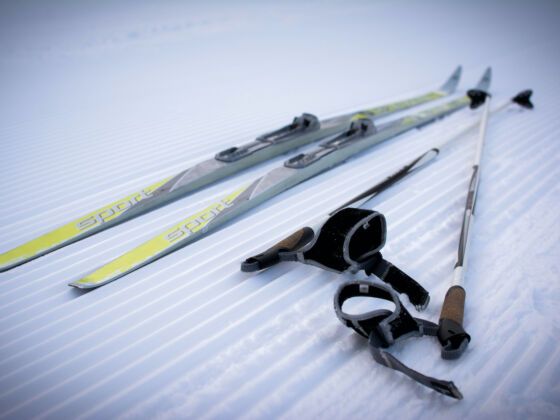Reports of sub-zero temperatures and bone-numbing wind-chill have been whistling out of Korea, where the Winter Olympics are taking place, but what’s not as widely publicized is the problem with the snow. That all-important ingredient of a winter sports celebration can’t be depended on to fall here. Pyeongchang gets variable levels of snowfall and big blizzards are rare. In February 2017 it snowed just seven days.

In response, the Games organizers have brought in 250 snow cannons and installed three pumping stations to manufacture artificial snow. In total, 80 percent of the snow-based events will take place on artificially-created snow. But these snow cannons aren’t just shoring up the Olympics. Increasingly, they are relied on by ski resorts around the world to compensate for patchy snowfall and guarantee the winter season. Far from being a handy solution to dwindling snow levels, though, making artificial snow is hugely damaging, in a whole host of ways.
Why some travelers are saying “no” to fake snow
1. Manufacturing snow is environmentally disastrous.
Vast amounts of water are needed to make artificial snow. In some regions of the Alps, for example, more than 50% of the available drinking water is directly used for snow production each day. This has impacts on local communities, creating water shortages. Artificial snow is also harmful to the environment, as its chemical composition disrupts natural biodiversity and harms wildlife.
2. It’s made to suit our calendars.
We want to go skiing and snowboarding when we want to go skiing and snowboarding — period. We don’t want to wait for the snow to fall naturally. We also really like to go at Christmas, New Year, or Easter, please. This means that resorts, which can make up to a third of their income during the festive period alone, are under pressure to provide snowy slopes from November into late April, which creates a reliance on snow cannons, whether that’s a natural time for snowfall or not.
3. Using artificial snow is not a long-term solution to dwindling snow levels.
With the earth warming, snowfall is decreasing. It’s falling later and melting sooner, too, so resorts are increasingly depending on making snow to survive.
4. It’s super expensive to make.
It’s estimated that producing artificial snow for the Winter Olympics could cost around $6 million. Obviously, the Olympics are a “money is no object” event, but ski resorts trying to stay open by making fake snow don’t have that kind of financial back-up.
5. There’s an increased risk of accidents.
Artificial snow is four times harder than natural snow, which brings with it a higher risk of injury if you fall on it. It’s formed of little balls of ice, doesn’t feel remotely powdery, and the quality is inconsistent, depending on the weather conditions, additives, and the machinery used to make it. In ski resorts, the runs that are artificially snowed and remain open can become overcrowded, too, which ups the risk of accidents.
6. Fake snow creates a fake landscape.
Pyeongchang’s artificially-snowed slopes make look impressive, but many European ski resorts where snowfall is patchy and fake snow is relied upon look far less wintery during a typical season. Bare brown mountains with ribbons of artificial snow threading down the slopes are not the pristine snowy wilderness that most winter sports fans love. This is very much a man-made environment, not a natural one — and is far less enjoyable to be in.
What’s the answer?
Think about altitude, latitude, and timing.
Anyone looking for an authentic winter break on real snow should head higher, where you can still enjoy great downhill skiing, but on real snow. Do some research. Look for resorts with high altitude slopes — in Europe, that means up to 3,500m — high-altitude lifts, north-facing slopes, and historically reliable snow cover. Googling the resort you’re interested in will reveal if it has snow cannons, but ask questions to find out when and where artificial snow is likely to be used. Are there high slopes that never need it? Does snow reliably fall in January so the cannons aren’t used then? Quiz your holiday supplier for their stance on artificial snow. Some companies are starting to say no to fake snow altogether: at Responsible Travel in the UK, where I work as a writer, we now only promote winter sports holidays that either take place where no fake snow is produced or run when the likelihood of snow being manufactured is low.
You can also search out skiing regions that offer a good range of other activities. In the Austrian Tyrol, for instance, you can downhill ski, but the region is famed for its cross-country skiing. Organized holidays here might include winter walking (which isn’t snow dependent) and snowshoeing, too. These activities can travel to where the snow has fallen. Downhill skiing can’t do that; it depends on resorts with infrastructure and manufactured slopes, and that in itself can lead to a dependency on artificial snow.
Travel to higher latitudes, too. In Europe, that means looking towards Scandinavia and the Arctic Circle rather than the Alps. In Finnish and Norwegian Lapland you’ll find spellbinding winter wildernesses covered in pristine snow, and the chance to do way more than just skiing — dog sledding, snowshoeing, cross-country skiing and ice fishing are all available. You might even spot the Northern Lights.
Think about when you travel, too. The skiing industry’s focus on Christmas, when snowfall can be patchy, and on extending the season into Easter, which can fall as late as mid-April, has increased the demand for artificial snow. This is a recent development. Before we could make fake snow, we only did winter sports when conditions permitted. The first skiers, over a century ago, would not have expected guaranteed snow from November to April. So for a better chance of enjoying the real white stuff, go when winter is in full swing — in January, February, even early March.